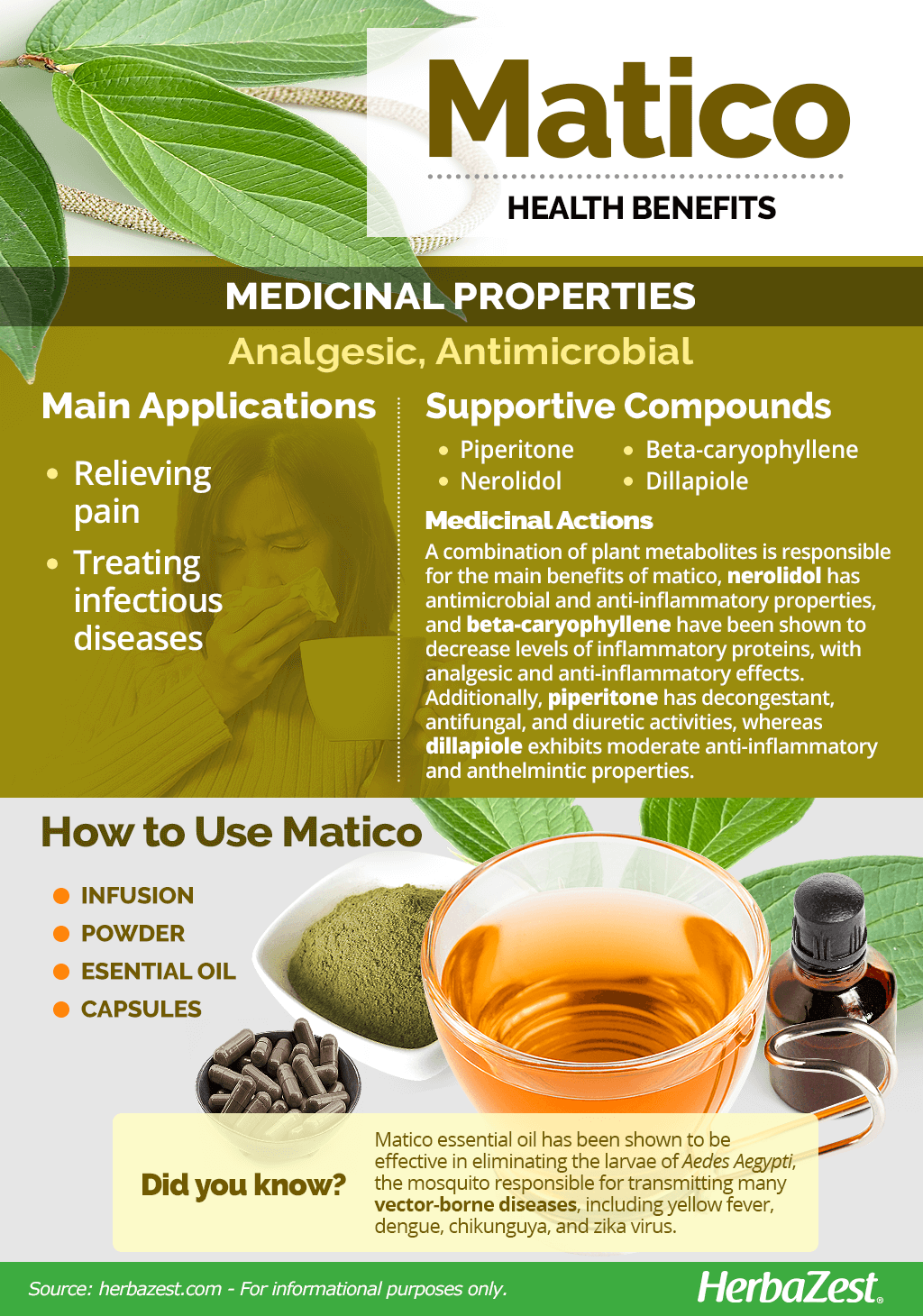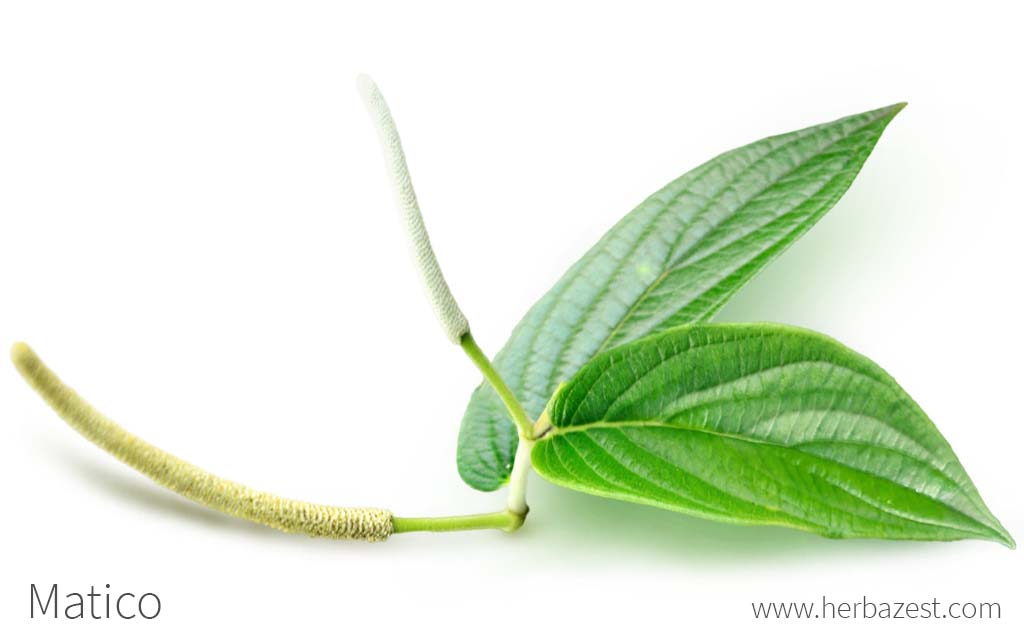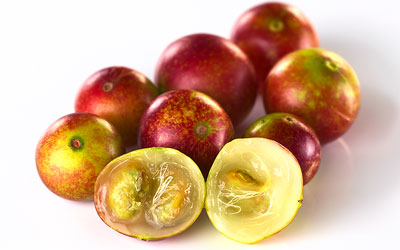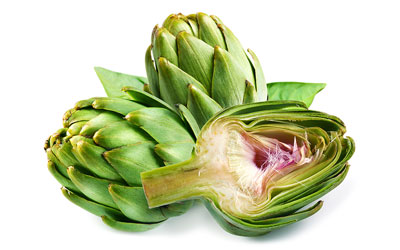Native to the Amazonian region, matico, also known as spiked pepper, grows in tropical zones of Central and South America, from Mexico to Argentina, as well as the Caribbean and parts of South Asia. This evergreen shrubby tree is particularly abundant in the Peruvian Amazon, where it has been traditionally used in folk medicine for a wide variety of purposes, from alleviating menstrual pain and headaches to treating respiratory diseases, wounds, and ulcers. Nowadays, matico is still being valued for its analgesic and antimicrobial properties, and science is investigating its potential applications.
Matico Medicinal Properties
Health Benefits of Matico
Matico has a long history of medicinal uses in the tropical areas where it naturally grows. It wasn't until recently that science started to explore and evaluate the scope of matico's analgesic and antimicrobial properties and its potential applications for human health. According to traditional practices and recent studies, the most important benefits of matico are:
Relieving pain. Due to its analgesic compounds, matico leaves have been used in folk medicine for pain management, including toothaches, period cramps, and wound treatment.
Treating infectious diseases. The antimicrobial, antifungal, antiseptic, and anthelmintic properties of matico have proven effective in inhibiting bacterial strains that cause respiratory, gastric, and urinary diseases, also helping to eliminate worm infestations.
In the indigenous areas where it naturally grows, matico has been traditionally used to treat a wide number of health conditions, including asthma, bronchitis, cough, abdominal pain, diarrhea, and rheumatism.
How It Works
The health benefits of matico leaves come from high amounts of plant metabolites. They contain sesquiterpenes, mainly nerolidol, with antimicrobial and anti-inflammatory properties, and beta-caryophyllene, which has shown to influence the endocannabinoid system and to decrease levels of inflammatory proteins, causing analgesic and anti-inflammatory effects.1,2,3 Additionally, piperitone has decongestant, antifungal, and diuretic activities, whereas dillapiole exhibits moderate anti-inflammatory and anthelmintic properties.
Matico essential oil has been shown to be effective in eliminating the larvae of Aedes Aegypti, the mosquito responsible for transmitting yellow fever, dengue, chikungunya, and Zika virus.4
Other herbs with analgesic properties are devil's claw, clove, and feverfew, whereas antimicrobial, antibacterial and antifungal effects can be obtained from marjoram, muña, and spearmint.
Side Effects and Cautions
While no toxicity effects have been reported in humans, and the use of matico is considered mostly safe, this herb is toxic to many pests and parasitic organisms due to its insecticidal and acaricidal effects, and it should be consumed with caution under medical advice.
- Medicinal action Analgesic, Antimicrobial
- Key constituents Beta-Caryophyllene, dillapiole, nerolidol, piperitone
- Ways to use Capsules, Hot infusions/tisanes, Powder, Essential oil
- Medicinal rating (2) Minorly useful plant
- Safety ranking Use with caution
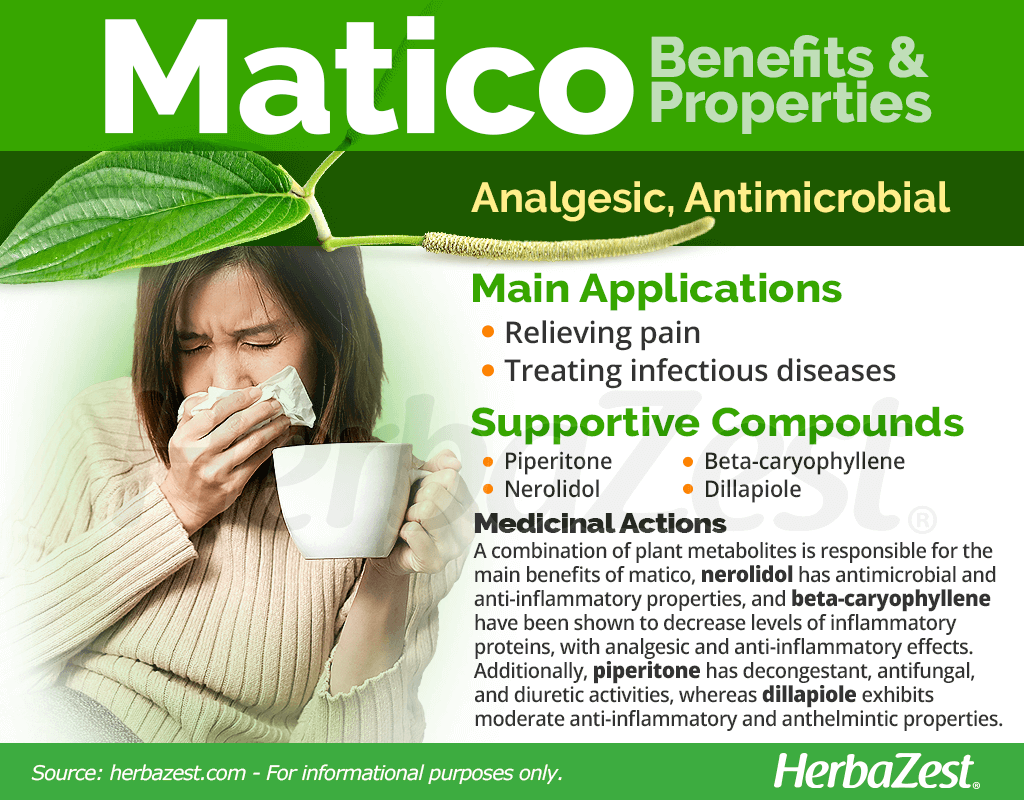
How to Consume Matico
Both the fruits (peppery and sweet when ripe) and the leaves of matico are consumed in culinary ways; however, these uses are restricted to the indigenous areas where it naturally grows. In order to extract all the healing properties of matico leaves, they have to be consumed in medicinal preparations.
Natural forms
Infusion. Dry matico leaves are usually infused in hot water to extract their beneficial properties. A matico leaf tea can be useful for helping reduce fever, rheumatic pain, headaches, and menstrual cramps, as well as respiratory conditions such as asthma, bronchitis, and cough.
Poultice. Due to their antiseptic and antimicrobial properties, matico leaves have been traditionally crushed, macerated, and applied topically to alleviate skin problems, such as acne, rashes, and superficial wounds.
Powder. Once dried and pulverized, matico leaves can be used to make tea as well as be topically applied as a paste. Matico powder can also be consumed as a supplement, in capsules.
Herbal remedies and supplements
Essential oil. Matico essential oil has been shown to have strong antibacterial and antifungal activities, and can be used topically to treat skin conditions, as well as be diluted in water to be taken orally for treating pain, diarrhea, and viral symptoms.
Capsules. Matico capsules are commonly used in convenient, standardized doses for a wide variety of medicinal purposes, mainly for alleviating pain and inflammation, as well as for treating gastric ulcers and arthritis.
Gels and creams made from matico are also available for the treatment of small wounds and skin regeneration; however, they can contain Piper aduncum or Buddleja globosa (Chilean matico), since both plants have similar cicatrizant and antiseptic properties.
- Edible parts Leaves
- Taste Aromatic, Spicy
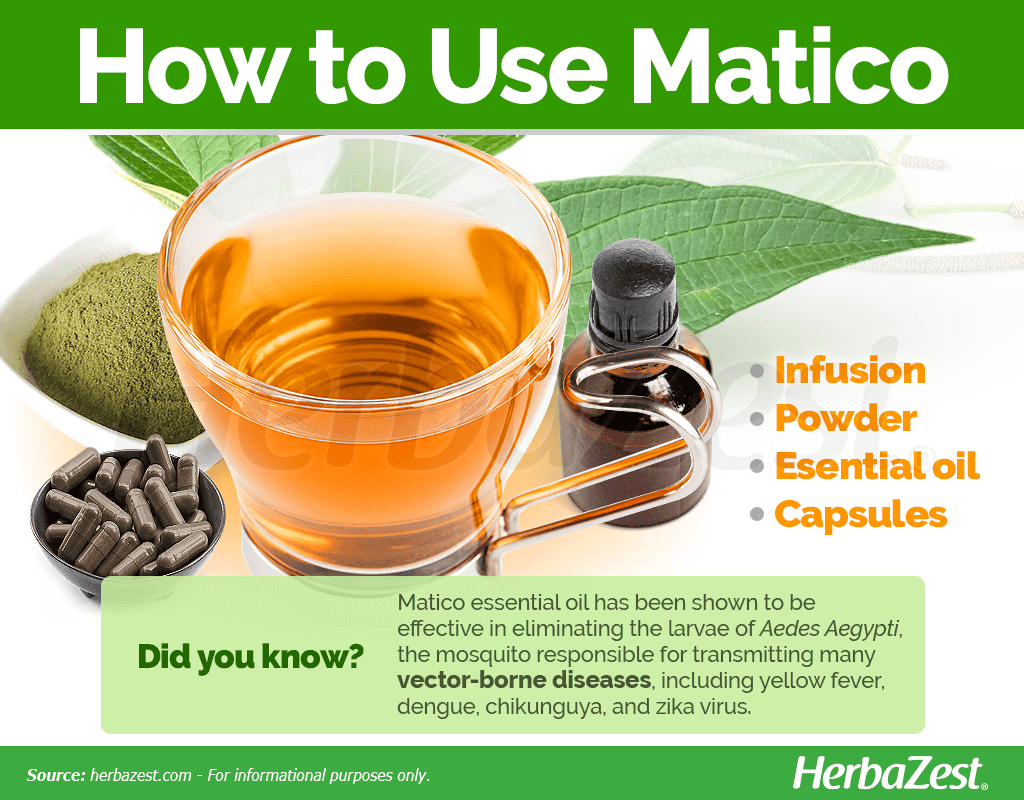
Growing
Matico (Piper aduncum), also known as false matico and spiked pepper, is an evergreen shrub native to tropical areas of Central and South America, and it requires specific conditions of humidity, soil, and temperature to thrive. It grows best in areas up to 3,281-6,562 feet (1,000-2,000 m) above sea level, with an average annual rainfall from 1,500 - 4,000 mm or more. However, this shrubby tree can be a nice addition to a garden if local conditions are met.
Growing Guidelines
The matico plant, or spiked pepper, thrives in loamy, nutrient-rich soil with a moderated amount of humidity. Enriching the substrate with organic matter is recommended if necessary. Matico requires frequent irrigation if rainwater is insufficient, but well-drained soil is a must to avoid waterlogging.
It grows better with plenty of direct sunlight but is tolerates partial shade, within a range of temperature of 68-86°F (20-30°C). Temperatures over 95°F (35°C) will inhibit seed germination.
Matico plants naturally reproduce by seeds, but the most common way to propagate them is through suckers and cuttings about 3.9 inches (10 cm) long, which are kept in a greenhouse for 60 days before transplanting.
Matico is considered an invasive species, quickly taking over the land through sprouts and suckers, which can grow rapidly and choke out surrounding vegetation. Birds also contribute to the plant's spread by scattering its seeds.
If left unattended, matico trees can grow multiple stems, making access difficult and preventing sunlight to reaching the ground beneath. For this reason, frequent pruning and weeding are necessary.
The matico plant is susceptible to root rot if waterlogged and can be affected by the same diseases that plague its Piper relatives, such as viruses and wilt.
- Life cycle Perennial
- Harvested parts Leaves, Fruit
- Light requirements Full sun
- Soil Loamy sand, Well-drained
- Growing habitat Tropical regions, Warm climates
- Propagation techniques Cuttings
- Potential diseases Root rot, Viruses
Additional Information
Plant Biology
Matico, also known as spiked pepper, is an evergreen shrub or small tree that can grow 7-26 feet (2-8 m) tall. It thrives in warm, humid environments and can be cultivated both indoors and outdoors. Its spreading canopy is composed of many branches, as well as twigs and leaves, with a peppery taste and smell. Matico leaves are alternate, sometimes in 2 rows, with short petioles 0.1-0.2 inches (3-5 mm) long, blades 5-7 inches (13-8 cm) long by 2-3 inches (4-7.5 cm) wide, rounded at the base, with smooth edges. The underside is pale, narrowly elliptical, with soft hairs and yellowish-green color.
Matico flowers grow in solitary, spiky clusters that are curved in opposite direction to the leaves. They start yellowish but turn grey-green when the fruit forms. The flowers are numerous and inconspicuous, each less than 0.04 inches (1 mm) long, formed by 4 stamens, a pistil with a one-celled ovary, 3 stigmas, and a scale-like bract. Matico fruits are ovoid drupes, trigonous, with a pale green hue, slightly more than 0.04 inches (1 mm) long, slightly juicy, containing a brown or black seed less than 0.4 inches (1 cm) long. Matico leaves, fruits, and seeds have a peppery taste and smell.
Classification
The botanical name of matico is Piper aduncum, and it belongs to the pepper family (Piperaceae), which consists of five genera and over 3,000 species, all of them native to the tropics. Due to their abundance and economical value, there are two particularly important Piperaceae genera: Piper and Peperomia.
Related species
Matico (Piper aduncum) is part of the Piper genus, which comprises over 2,000 species, famously including black pepper (Piper nigrum), long pepper (Piper longum), and kava kava (Piper methysticum), along with many other aromatic plants with culinary and medicinal uses.
Historical Information
Matico, or spiked pepper, originated in Central and South America and has a long history of traditional uses that were adopted by the first Europeans settlers, whom valued the antiseptic, analgesic, and antimicrobial qualities of the plant.
Matico was later introduced to other latitudes as an ornamental species. There are records of its cultivation in West Java around 1860s, where it quickly became a problem due to its invasive nature. Nowadays, wild populations of matico are common in Southeast Asia, including Indonesia, Malaysiam and Papua New Guinea, as well as the Pacific Islands of Vanuatu, Fiji and the Solomon Islands.
In Australia, particularly on Christmas Island, matico is considered a dangerous species, and its cultivation is prohibited.
Economic Data
In spite of its valuable medicinal properties and long history of use, matico is not a particularly relevant commodity, so there is no data about its trade and production.
Other Uses
Gardening. In places where matico is not banned, this plant is used as an ornamental in gardens and roadsides.
Fuel. The brittle wood of matico stems makes for a good source of fuel, and its biomass has shown to be a promising alternative for gas generation.
Insecticide. This is a traditional use that has been rediscovered by the industry, and there is a growing interest in the acaricidal and insecticidal properties of matico for agro-industrial and pharmaceutical purposes.
- Other uses Fuel, Repellent
Sources
- Biological and Applied Sciences, Brief Review on Piper aduncum L., its Bioactive Metabolites and its Potential to Develop Bioproducts, 2023
- Boletín Latinoamericano y del Caribe de Plantas Medicinales y Aromáticas, Antibacterial activity of the Piper aduncum oil and dillapiole, its main constituent, against multidrug-resistant strains, 2014
- Brazilian Archives of Biology and Technology, Brief Review on Piper aduncum L., its Bioactive Metabolites and its Potential to Develop Bioproducts, 2023
- International Journal of Molecular Sciences, Essential Oils from Neotropical Piper Species and Their Biological Activities, 2017
- Iranian Journal of Arthropod Borne Diseases, Evaluation of Piper aduncum Linn. Essential Oil (Fam:Piperaceae) against Periplaneta americana (L.), 2009
- ISRN Pharmaceutics, Piper aduncum Essential Oil Rich in Dillapiole: Development of Hydrogel-Thickened Nanoemulsion and Nanostructured Lipid Carrier Intended for Skin Delivery, 2022
- Journal of Medicinal Plants Research, Antimicrobial activity of essential oil of Piper aduncum L. (Piperaceae), 2012
- Molecules, Essential Oils from Colombian Plants: Antiviral Potential against Dengue Virus Based on Chemical Composition, In Vitro and In Silico Analyses, 2022
- Parasite, Piper aduncum essential oil: a promising insecticide, acaricide and antiparasitic. A review, 2021
- Planta Medica, Anti-inflammatory Flavonoid C-Glycosides from Piper aduncum Leaves, 2016
- Plantas Medicinales de Panamá, pp. 402-406
- Revista Peruana de Medicina Experimental y Salud Pública, Determination of the healing effect of Piper aduncum (spiked pepper or matico) on human fibroblasts, 2016
- Sains Malaysiana, Medicinal Uses, Phytochemistry, and Pharmacological Properties of Piper aduncum L., 2020
- Toxics, Antioxidant and Cytoprotective Effect of Piper aduncum L. against Sodium Fluoride (NaF)-Induced Toxicity in Albino Mice, 2019
- Vive Revista de Salud, Piper aduncum L. (matico) used as a treatment for lung damage and Covid-19, 2021
- Phytotherapy Research, Antimicrobial Properties of the Constituents of Piper aduncum, 1998
Footnotes
- Molecules. (2016). Nerolidol: A Sesquiterpene Alcohol with Multi-Faceted Pharmacological and Biological Activities. Retrieved September 3, 2024, from: https://www.ncbi.nlm.nih.gov/pmc/articles/PMC6272852/
- Trends in Pharmacological Sciences. (2016). Beyond Cannabis: Plants and the Endocannabinoid System. Retrieved September 3, 2024, from: https://www.sciencedirect.com/topics/pharmacology-toxicology-and-pharmaceutical-science/caryophyllene
- Cancer Medicine. (2016). β‐caryophyllene and β‐caryophyllene oxide—natural compounds of anticancer and analgesic properties. Retrieved September 3, 2024, from: https://www.ncbi.nlm.nih.gov/pmc/articles/PMC5083753/
- Tropical Biomedicine. (2011). The effect of Piper aduncum Linn. (Family: Piperaceae) essential oil as aerosol spray against Aedes aegypti (L.) and Aedes albopictus Skuse. Retrieved September 4, 2024, from: https://citeseerx.ist.psu.edu/document?repid=rep1&type=pdf&doi=987036f33377abb90b0e5c9ffcf7bed293db21ab
